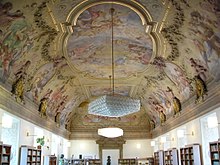Hradisko Monastery
This article includes a improve this article by introducing more precise citations. (August 2022) ) |
Klášter Hradisko | |
Order of Saint Benedict (until 1151) Premonstratensians (until 1784) | |
| Established | 3 February 1078 |
|---|---|
| Disestablished | 18 August 1784 |
| Dedicated to | Saint John |
| People | |
| Founder(s) | Otto I of Olomouc and wife Euphemia of Hungary |
| Architecture | |
| Functional status | Olomouc military hospital and public heritage site |
| Heritage designation | 262/1995 |
| Designated date | 16 August 1995 |
| Architect | Giovanni Pietro Tencalla |
| Style | Italian Mannerism (northern part of the monastery) and High Baroque (Prelature building) |
| Site | |
| Location | Olomouc, Olomouc Region, Czech Republic |
| Coordinates | 49°36′22″N 17°15′55″E / 49.60611°N 17.26528°E |
| Other information | Czech Heritage Site |



Hradisko Monastery or Monastery Hradisko (
Etymology
In Moravia, Hradisko more often refers to a castle settlement—from Czech Hradiště (Hillfort, Gord): a fortified settlement from the Neolithic to Early Middle Ages, the forerunner of medieval castles and towns.
History
North of
In 1151, the monastery reached a significant milestone when the Benedictine monks were expelled from Olomouc and the monastery was assigned to the Order of the Premonstratensians. The Benedictine monks were forced to leave Hradisko and found reception at the Opatovice nad Labem monastery (cs:Opatovický klášter) in east Bohemia. This change may have been linked more broadly with the former trend when the Premonstratensians became a mainstay of religious reform and the papacy, and therefore their arrival in the Czech lands was accompanied by hostility towards the Benedictines. In 1784, Emperor Joseph II abolished the monastery, ending more than six hundred years of the Premonstratensian monastery. At the time, more than 70 monks lived in the monastery, who mostly devoted themselves to spiritual administration.
In the 18th century the monastery was a centre of Jansenism. After the secularization of church property in 1783, the monastery served as the Moravian General Seminary for the priesthood education until 1790. After the death of Emperor Joseph II, the seminary was cancelled and the former monastery was handed over to the army. The army established a warehouse at first and during the Napoleonic wars in 1800 a French prisoner of war camp. From 1802 it was used as a military hospital. Today, the freely accessible facility continues as home to the Olomouc military hospital.
Architecture
The monastery grounds changed its appearance as the result of various historical events. During the centuries, Hradisko monastery was plundered, devastated and destroyed several times: 1241 by the
The present-day buildings were built in the spirit of
Attractions
- The abbey church was comprehensively redesigned in 1730. The Moravian "high baroque" painter Johann Christoph Handke (cs:Jan Kryštof Handke) created the ceiling artwork.
- The interior prelature decoration was presumably established according to plans by the Italian architect sculptor, stucco plasterer and architect of "late baroque" Baldassarre Fontana, the Italian painter Innocenzo Monti, the Moravian baroque sculptor Jiří Antonín Heinz and the German sculptor Josef Winterhalder. The hallway paintings were created by the leading Austrian painters Daniel Gran and Paul Troger who created the monumental ceiling fresco on the theme of Christ's Feeding of the 5000 in the year 1731. The fresco is surrounded by a painting of illusive architecture by the Italian painter Agostino Tassi.
- Equally significant is the painting and stucco decoration of the library's vaults.
The former refectory ceiling artwork and sculpture of saint John of Nepomuk among other sculptures and reliefs in the ceremonial hall were created by Josef Winterhalder the Elder:
-
Samuel greeting Saul
-
Peter's denial
-
Apostle Paul's wreck on the isle Malta
List of abbots
List of abbots of Hradisko Monastery till 1350:
- Jan (1078–1081)
- Bermar (1081–1116)
- Paulinus (1116–1127)
- Deocarus (1138–1144)
- Jiřík (cca 1149–1159)
- Blažej (mentioned to 1160)
- Michal (mentioned to 1174)
- Dětřich (1184–1189)
- Hilar (mentioned to 1200)
- Heřman (1201–1216)
- Bonifác (1221–1223)
- Petr (1225–1230)
- Řivín (mentioned to 1232)
- Gerlach (1233–1238)
- Bonifác (1238–1239)
- Robert (1240–1267)
- Budiš (1269–1290)
- Roman (1290–1300)
- Bohuslav (1310–1315)
- Jindřich (1315–1322)
- Tomáš (1322–1332)
- Frydrych (1332–1336)
- Augustin (1336–1350)
- Mikuláš Rús (~1453)




